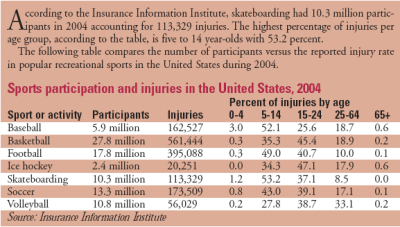Cities across North America often shy away from building skate parks, citing fear of liability as the main reason for pause. However, the Skate Park Association of the United States of America (SPAUSA) shows statistically higher percentages of injuries occur in hockey, football, basketball, soccer, baseball and volleyball per number of participants.
Attorney David Amell states in his doctrine, “Assumption of Risk,” that starting in the early 1990s, courts throughout the country established common law doctrines limiting the ability of plaintiffs to recover for injuries sustained while participating in “hazardous” or “risky” recreational activities (HRAs). The California Supreme Court led this movement with its decision in Knight v. Jewett, 3 Cal.4th 296, 834 P.2d 696, 11 Cal.Rptr.2d 2 (1992). Negligence claims for sports injuries have consequently been limited substantially. Yet, according to industry experts and advocates, public perception has not caught up with reality. “The fear of liability has prevented private and public entities from encouraging or allowing risky recreational activities,” despite liability-limiting statutes passed by legislatures, Amell said. Skate parks stand at the forefront of that dilemma.
Karen Oxman, principal of Encino, Calif.-based GNW-Evergreen Insurance Services LLC, has written coverage for skate parks for nearly 10 years. She said although it is not a huge market, skate park coverage is accessible.
“We have not had the claims develop the way we thought they were going to,” she said, “so the price is very good. In fact, I think it is a little on the low side.”
According to Oxman, an average annual premium a new skate park might pay for $1 million of coverage is $2,500. “I don’t think there is any skate park out there, that I am aware of, that can’t get a quote on something, unless they’ve had a terrible experience.”
SPAUSA Executive Director Heidi Lemmon said the low claims rates don’t surprise her. “Most of the people who get involved in this sport realize they are probably going to get injured,” she said, likening enthusiasts to those who pursue football or hockey. “The thing that is surprising is how many cities will say ‘we don’t want the liability’ when proposed with the idea of putting in a skate park. But the same people will turn around and put in a dog park,” she said. “When you look at the fact that around 800,000 people in the U.S. end up in an emergency room every year due to dog attacks and pay $350 million a year in related law suits, it doesn’t make sense.”
A high risk activity
Doug Wyseman, a risk management consultant for public entities, said the purpose of having something classed as an HRA is for liability protection. “Participants know the risk, but want to do it anyway so they assume the risk and away they go,” he said.
HRA-designation is statutory though, and laws differ by state. Lemmon cited Washington as a state with clear skate park laws that might serve as a model for other states. In 1997, Washington legislation amended the recreational user statute, RCW 4.24.210, expanding covered activities allowed on public and private property to include skateboarding. That meant that its cities would not be held responsible for injuries sustained by skateboarders or inline skaters at city-operated skate parks as long as a fee was not charged for use of the park and conspicuous signs were posted to warn of any known dangerous, artificial or latent conditions.
In contrast, recent tort reform on HRAs in California has created loopholes for trial lawyers to go after municipalities in recovering injury claims on public skate parks, Wyseman said. Without an HRA designation, any claim of injury would fall under “assumption of risk,” which is essentially the same the situation, he said. “For example, you don’t jump out of a plane with out realizing there is some risk. Whether someone tells you it is a high-risk activity or not, you should inherently know it is,” he said. This fact, combined with the low claims rates coming out of skate parks in North America, illustrates the confused reasoning for recent changes in California.
Cities don’t want to build skate parks citing liability as the main reason, yet there are few to no claims. “On one hand, you’ve got people afraid that the sport is too dangerous and, on the other hand, they won’t call it a high risk activity,” Wyseman added.
“I would understand if we were seeing $350 million in lawsuits and 800,000 injuries as a result of skate parks, but that is not what we are seeing,” Lemmon said. “Our injury rates are running around 0.03 percent on unstaffed parks.”
Claiming that skate parks are misunderstood, Lemmon emphasizes the need for them. “This country has a major problem with its young people. They don’t feel connected … there is a huge drug problem and just a lack of resources for kids,” she said.
Topics California Claims
Was this article valuable?
Here are more articles you may enjoy.



 Chubb to Acquire MGA Healthy Paws From Aon
Chubb to Acquire MGA Healthy Paws From Aon  Former Congressman Charged After Collision with State Trooper in Florida
Former Congressman Charged After Collision with State Trooper in Florida  Uncertainty Keeps Prices Up; No Prior-Year Loss Development: Travelers
Uncertainty Keeps Prices Up; No Prior-Year Loss Development: Travelers  JPMorgan Client Who Lost $50 Million Fortune Faces Court Setback
JPMorgan Client Who Lost $50 Million Fortune Faces Court Setback 


